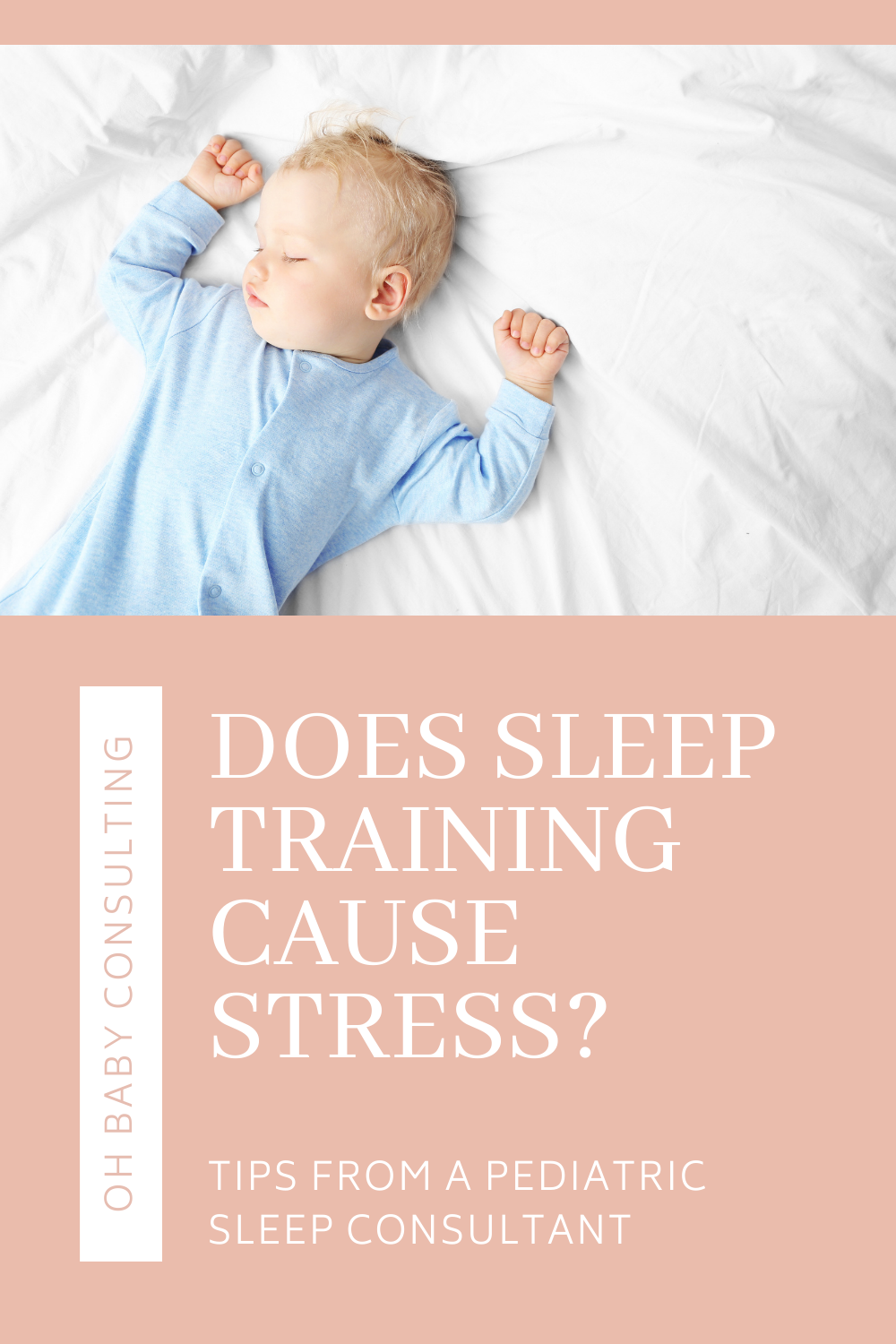Does Sleep Training Cause Stress?
A common sleep training question I get from parents is whether or not their babies will be stressed during the process. With so much misinformation circulating the internet, it’s a natural worry. As someone with a background in psychology and child development, I want to answer this question from an evidence-based perspective and debunk the scare-tactics once and for all.
The Background:
Concerns about stress and elevated cortisol levels are often cited back to a 2012 “study” done by Middlemiss.
Here are the details:
25 infants ages 4-10 months were taken to a hospital to participate in “inpatient” sleep training research. At bedtime, the infants were handed over to nurses who put them down in cribs and let them cry – with no intervention or soothing – until they fell asleep. This was repeated for 4 days. On two of the testing days, saliva was taken from both mother’s and baby’s mouths both at bedtime and 20 minutes after sleep onset to measure cortisol levels – a stress hormone. The findings from the study included elevated levels of cortisol, but upon closer examination, the conclusions of this study actually tell us absolutely nothing about whether sleep training is problematic in any way.
What’s Wrong with this Study?
Well, kind of a lot!
1. The study only took 2 days of measurements
The study only took cortisol measurements on days 1 and 3. With only 25 participants to begin with, this is an extremely small sample. Not to mention, not all 25 participants had their saliva sampled on both nights. The missing data here makes it difficult to conclude much of anything. Additionally, there were no follow-ups of any kind to explore any longitudinal questions.
2. The study lacked a control group
You don’t have to have a background in research methods to know that if you’re conducting a study with an intervention (aka trying to determine the effects of something), you need to have a control group. That is, a group of people who you are comparing the results of your interventions to.
For (a very simplified) example, if you wanted to study the effect of caffeine on energy levels, you’d naturally want to have two groups: one who consumed caffeine and one who did not. The information you gathered on each group’s energy levels would give you valuable information about whether caffeine played a role or not.
This particular study placed babies in a very strange situation: they were in a new place, with new caregivers, placed in unfamiliar cribs without their parents, getting their mouths swabbed, etc. A good quality study would have also had a control group – babies in their own homes, with their own parents, in a familiar sleep environment, etc. (which is what real-world sleep training looks like anyway.) Because there was no control group, it is impossible to say why these babies had a rise in cortisol. The rise in cortisol could have been due to any number of the other strange factors vs. having anything to do with falling asleep without help.
3. There were no baseline measurements of cortisol taken
Another important feature of a well-conducted study is gathering baseline measurements. How do we know what “high” levels of cortisol are if we don’t know what “normal” cortisol was to begin with?
Additionally, cortisol is a naturally occurring hormone that does rise and fall throughout the day. Without gathering data on the baseline cortisol levels of the study participants, it’s very hard to make any type of conclusions.
4. The study was not representative of the sleep training experience
And finally, this study really was not meant to draw any conclusions about sleep training in general. Yep – you read that right. It was not a study looking for the effects of sleep training. If it were, it would at the very least have been done in-home and with parents present – a truly representative sample.
Instead, the purpose of this study was to examine the synchronicity of cortisol levels between mother and baby during said intervention. In short, it was meant to induce stress.
The (very loose) findings showed a mismatch of cortisol levels between mother and baby after 3 nights of the intervention and conclusions were extrapolated from there. But there is absolutely no reason why we should expect hormonal levels to always be equivalent between mother and baby. That’s a little ridiculous. As a matter of fact, it’s a bonus to the parent-child relationship if the parent can regulate their stress levels when baby is upset vs. stay in an elevated stress response to match their baby. This helps to enhance co-regulation and can assist baby in calming more quickly.
So this brief and ill-conducted study concludes that babies in a strange hospital setting with strange people and no parent around do experience elevated levels of cortisol. (Makes sense to me!)
But what about during sleep training at home?
While we don’t know for sure, it’s reasonable to assume that a child experiencing any type of newness – like being put down in their crib awake for the first time instead of being assisted to sleep – may elicit some upset and some sort of cortisol rise. I also think it’s reasonable to assume that the same type of upset and rise in cortisol can occur during bath time (especially for a baby who hates baths), doctor’s visits, car rides, new caregivers and other novel experiences.
The Truth About Stress
But just because stress has a negative connotation, it’s not always harmful or something that must be avoided. In fact, stress can be considered a very healthy and necessary part of development. Not only that, but certain types of stress experiences can also help build the brain’s architecture for resilience.
We all experience stress when faced with anything new or different. Examples include going to a new school, starting a new job, playing sports, traveling, making new friends, etc. The type of stress that these experiences induce is not at all dangerous and is in fact productive.
There are actually three types of stress identified in child development research: positive, tolerable, and toxic. To really understand what we mean when we talk about stress, it’s important to understand the nuances of these three different types.
Positive
Positive stress refers to mild to moderate stressful events such as starting a new school, adjusting to a new caregiver, going to swim class, getting shots at the doctor, or learning a new skill. Positive stress is both normal and essential for development. When this “newness” occurs in the context of stable and supportive relationships, it actually helps brain development and builds the brain’s architecture for self-regulation and resilience. While cortisol levels can stay high for periods of time during positive stress events, their eventual lowering does not indicate any type of “shutdown” but instead moving through and acclimating to the newness.
Tolerable
Tolerable stress includes periods of longer, more intense stress experiences where the body’s alert system is activated to a greater degree. Events that may fall into this category include severe accidents, hospitalizations & medical interventions, death of a loved one, etc. However, if these experiences are buffered by supportive relationships, development is protected from any long-term negative consequences.
Toxic
Toxic levels of stress occur with strong, frequent, and/or prolonged exposure to a stressor WITHOUT support of a loving caregiver to help the body return to a baseline level after the stress experience. Examples include chronic abuse and neglect, parental substance abuse or mental illness, or exposure to violence. Prolonged activation of the stress response system under these circumstances can have negative long-term consequences on development.
I think it’s pretty clear that sleep training is more closely aligned with starting a new school or going to swim class as opposed to chronic violence, abuse, or neglect. But don’t just take my word for it; there have been numerous studies outlining the negative effects of toxic stress on development, and there have also been numerous, well-conducted, and longitudinal studies on sleep training. None of the effects of toxic stress have ever been identified in any of the sleep training research.
For example, brain damage – one of the effects of toxic stress – is not only a huge claim but something that can be clearly and concretely identified. In addition to attachment and emotional disorders, this would be easily observed, measured, and reported on.
Instead, children who have been sleep trained have zero attachment, emotional, physical, or mental health differences than children who have not been sleep trained. In fact, one of the many longitudinal (five year) studies conducted suggested an increase in secure attachment behaviors in the days following sleep training. This makes sense given what we know about the impacts of chronic sleep deprivation on parental mental health and the wellness of the family unit.
Sleep Training is a Valid Choice
So while sleep training is certainly not the right choice for every family, it is a safe and valid choice if your family is struggling with sleep.
To learn more about sleep training, visit the links below:
If you want a sleep training plan + support through the process, please reach out. I’d love to work together to bring sleep back into your lives.
If you’re exhausted, totally overwhelmed by your child’s sleep habits, or looking for answers to the sleep questions that keep you up at night (literally), then you’ve come to the right place. I’m Jamie, founder of Oh Baby Consulting, and my goal is to help your family get the sleep you need to not just survive, but thrive!

